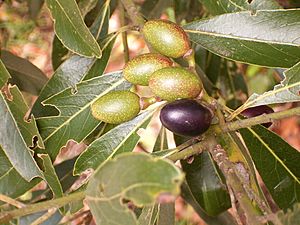Laurus novocanariensis facts for kids
Quick facts for kids Laurus novocanariensis |
|
|---|---|
 |
|
| Conservation status | |
| Scientific classification | |
| Genus: |
Laurus
|
| Species: |
novocanariensis
|
The Canary Laurel (Laurus novocanariensis) is a beautiful tree or large shrub. It has shiny, dark-green leaves that smell nice. This plant belongs to the laurel family, called Lauraceae. It is an evergreen tree, meaning its leaves stay green all year round.
This impressive tree can grow from 3 to 20 meters (about 10 to 65 feet) tall. It loves places with rich soil and lots of moisture in the air. You can find it in subtropical climates, especially in the cloud zones of the Canary Islands and Madeira.
Scientists used to think this tree was the same as Laurus azorica, which grows in the Azores. But now they know they are different species.
Contents
What Does It Look Like?
The Canary Laurel is a tall tree, sometimes reaching 20 meters (65 feet) high. It has a thick, cone-shaped top with many branches. Its trunk and branches can be green or gray.
Leaves
Its leaves are large, shiny, and dark green. They are shaped like a spear (lanceolate) or an oval. They feel leathery and have a lovely, delicate smell. This smell is much softer than the strong scent of the common bay laurel (Laurus nobilis). You can spot tiny glands where the main vein meets the side veins on the leaves.
Flowers and Fruit
The flowers of the Canary Laurel are small and creamy white. They smell sweet and grow in pairs next to the leaves. This tree flowers from November to April.
The fruit looks like a small olive. It's about 1 to 1.5 centimeters long. When the fruit is ripe, it turns black. Each fruit holds one seed.
Male and Female Plants
This tree is a "dioecious" species. This means there are separate male and female plants.
- Female plants are called "laurel" locally. Their flowers produce the fruit.
- Male plants are called "loro". Their flowers have many stamens (the parts that make pollen) but do not produce fruit.
For the seeds to grow, both male and female plants need to be in the same area so the flowers can be fertilized.
Special Growths on Trunks
Sometimes, you might see strange growths on the trunks of these trees. These are called galls. They are caused by a fungus named Laurobasidium lauri. People sometimes call this fungus Madrelouro.
Where Does It Grow?
The Canary Laurel is a key part of the laurisilva forests. These are special ancient forests found in a region called Macaronesia. However, this specific laurel species only grows naturally on the islands of Madeira and the western and central Canary Islands.
It often grows alongside other unique trees like Apollonias barbujana and Ocotea foetens.
See also

- In Spanish: Loro o laurel canario para niños


